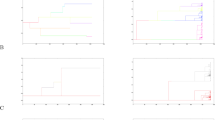Abstract
We apply matrix analytic methods and branching processes theory to a comparison of female populations in different countries. We show how the same mathematical model allows us to determine characteristics about individual women, such as the distribution of her lifetime, the time until her first and her last daughter, and the number of daughters, as well as to analyze properties of the whole female family generated by a first woman, such as the extinction probability of the family, the distributions of the time until extinction, of the family size at any given time and of the total progeny.
Similar content being viewed by others
References
Armstrong, JS (eds) (2001) Principles of forecasting: a handbook for researchers and practicioners. Kluwer, Norwell
Asmussen S, Koole G (1993) Marked point processes as limits of markovian arrival streams. J Appl Probab 30: 365–372
Asmussen S, Avram F, Usábel M (2002) Erlangian approximations for finite-horizon ruin probabilities. Astin Bull 32: 267–281
Athreya K, Ney P (1972) Branching processes. Springer, New York
Bean N, Kontoleon N, Taylor P (2008) Markovian trees: properties and algorithms. Ann Oper Res 160(1): 31–50
Belgian National Institute of Statistics (2009) http://www.statbel.fgov.be/pub/. Accessed 26 Jan 2009
Booth H (2006) Demographic forecasting: 1980 to 2005 in review. Int J Forecast 22: 547–581
Caswell H (2001) Matrix population models. Sinauer Associates, Sunderland
Choudhury GL, Lucantoni D, Whitt W (1996) Squeezing the most out of ATM. IEEE Trans Commun 44: 203–217
Gantmacher FR (1974) The theory of matrices. Chelsa Publishing Company, New York
Hautphenne S, Latouche G, Remiche M-A (2008) Newton’s iteration for the extinction probability of a Markovian binary tree. Linear Algebra Appl 428: 2791–2804
Hautphenne S, Latouche G, Remiche M-A (2009) Transient features for Markovian binary trees. In: VALUETOOLS ’09: Proceedings of the fourth international ICST conference on performance evaluation methodologies and tools. Lecture notes of ICST. Springer-Verlag, Berlin, pp 1–9. doi:10.4108/ICST.VALUETOOLS2009.7428
Hautphenne S, Latouche G, Remiche M-A (2010) Algorithmic approach to the extinction probability of branching processes. Methodol Comput Appl Probab 13(1). doi:10.1007/s11009-009-9141-7
Hoem JM (1976) The statistical theory of demographic rates. a review of current developments. Scand J Stat 3: 169–185
Keilman N, Pham DQ, Hetland A (2002) Why population forecasts should be probabilistic—illustrated by the case of Norway. Demographic Res 6:409–454. http://www.demographic-research.org/Volumes/Vol16/15/
Latouche G, Remiche M-A, Taylor P (2003) Transient Markov arrival processes. Ann Appl Probab 13(2): 628–640
Lee R (1998) Probabilistic approaches to population forecasting. Popul Dev Rev 24: 156–190
Lin XS, Liu X (2007) Markov aging process and phase-type law of mortality. North Am Actuarial J 11: 92–109
Norris JR (1998) Markov chains. In: Cambridge series in statistical and probabilistic mathematics, vol 2. Cambridge University Press, Cambridge, 1998. Reprint of 1997 original
Preston SH, Heuveline P, Guillot M (2001) Demography. Blackwell, Oxford
Préoccupations relatives à la santé, fiches documentaires, sex-ratio. http://www.emcom.ca/health/sexfr.shtml. Université d’Ottawa, Centre R. Samuel McLaughlin d’évaluation du risque sur la santé des populations. 9 Dec 2008
Stanford DA, Latouche G, Woolford DG, Boychuk D, Hunchak A (2005) Erlangized fluid queues with application to uncontrolled fire perimeter. Stoch Models 21: 631–642
The Human Fertility Database (2010) Max Planck Institute for Demographic Research and Vienna Institute of Demography. http://www.humanfertility.org/cgi-bin/main.php. Accessed 30 Sept 2010
WHO Statistical Information System (WHOSIS) (2010) World Health Organization. http://www.who.int/whosis/en/. Accessed 30 Sept 2010
World Population Prospects: The 2008 Revision Population Database (2008) United Nations Population Division. http://esa.un.org/unpp/. Accessed 30 Sept 2010
Author information
Authors and Affiliations
Corresponding author
Rights and permissions
About this article
Cite this article
Hautphenne, S., Latouche, G. The Markovian binary tree applied to demography. J. Math. Biol. 64, 1109–1135 (2012). https://doi.org/10.1007/s00285-011-0437-1
Received:
Revised:
Published:
Issue Date:
DOI: https://doi.org/10.1007/s00285-011-0437-1




